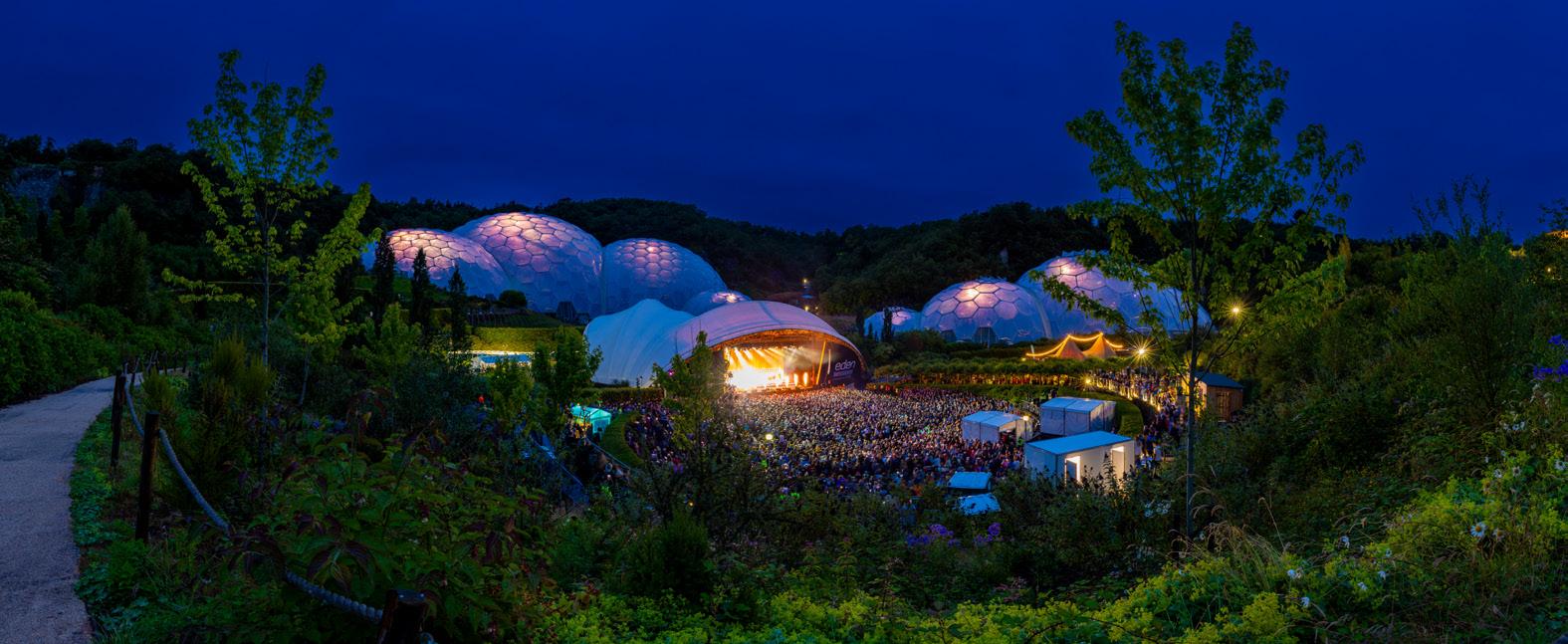
10 minute read
Sir Tim Smit and The Eden Project
By Paul Manias
Tucked away down the narrow country lanes of Cornwall, amidst undulating hills and patchwork fields, a former clay quarry that operated for over 160 years has been transformed from a mining site into a celebration of nature and agriculture – The Eden Project. As Eden celebrates its 24th anniversary in March this year, we caught up with its co-founder and passionate advocate for sharing awareness of plants, the planet, and protecting the environment – Sir Tim Smit.
The first thing to understand about Cornwall’s iconic ecotourism visitor attraction – The Eden Project – is not to think of it, or indeed describe it, as a ‘theme park’. Eden’s cofounder and Executive Vice-Chairman, Sir Tim Smit, likes to think of it instead as a ‘theatre of horticulture and agriculture’. Rather than a place that entertains its visitors with fantasies and thrills, Eden leaves those who have experienced it, wonderstruck by its scale and ambition with the largest greenhouses in Europe reaching 50 metres in height for the Rainforest Biome. It informs visitors with its narratives of nature, communities, and sustainability; inspires with its ethos of protecting Planet Earth ‘Our only home’; and aims to empower visitors through its displays to take away some of the messages it offers and become part of its huge extended community through its annual Big Lunch that sees millions participate across Britain.

I caught up with Sir Tim in autumn of last year at the Lost Gardens of Heligan, another of his projects and in many ways the prelude for Eden’s main performance. If that sounds like its referencing music, then its deliberate and there is a theme to how Heligan and Eden, together with the group’s new projects, are curated.
Tim Smit was born in the Netherlands and educated in the UK, studying anthropology and beginning a career in archaeology before switching to music. He spent a decade in the music industry finding success as a composer and producer, attaining several Platinum and Gold records. In 1987, he left the world of music behind and headed west to Cornwall for a simpler life with his wife Candy and family, to connect with nature.
The discovery of Heligan was to be an epiphany for Smit. Originally seeking a place to farm rare breeds, he met John Willis who had inherited a large, overgrown estate. Their exploration of Heligan included the discovery of a humble ‘thunderbox room’ for workers that held the memory of kitchen gardeners from the preWorld War I era. “It was the loss of gardeners in WWI that made me want to tell the whole opera of gardens like this. There wasn’t a single garden left that showed the work and skills of these workers,” said Smit.
Teaming up with Peter Thoday, best known for the 1987 BBC series The Victorian Kitchen Gardens, the journey of reawakening Heligan’s lost gardens and artisan gardening practices began. “We wanted to tell the story of agriculture as an applied science,” said Smit. “These days we lose top gardeners to hedge fund managers who want posh gardens.” Rebuilding the greenhouses, researching the techniques of the Victorian and Edwardian gardeners, were all fundamental to restoring Heligan’s glorious 200 acres of historic gardens that after 30 years continue to attract visitors.
Out of the ideas from the Lost Gardens of Heligan came the genesis for the Eden Project. “In the late 1990s, a small group gathered in pubs and offices to talk about an idea – to create a place like nothing anyone had ever seen before; a place that explored our place in nature, a place that demonstrated what could be done if people who wanted to make a difference got together,” said Sir Tim Smit in his book Eden. “It was ridiculous to imagine it was possible and that hundreds of people, trained to say no, could be persuaded to say yes. But the greybeards had a brilliant plan: ask the youngsters to do it –they don’t know it can’t be done.” What lay ahead was a long and often unproductive search for a suitable site till finally a clay pit near Bodelva provided the vision for what Eden could become. If seeking a site was a challenge, it was nothing compared to the task of realising the project, finally convincing investors including the Millenium Commission who initially turned it down along with a host of others to get behind it. The challenges of the site were compounded by a period of monumental rainfall and delays while they shored up the walls of the quarry with some 2,000 rock anchors, meanwhile growing the plants and fabricating the 83,000 tonnes of soil needed.
It's a clue to Smit’s ethos that within his book the only photo you’ll find of him amongst the many images of those involved with Eden’s creation, is not on the covers and indeed is with other colleagues. He is very much about the team effort and his role to engender the same enthusiasm and positivity he has within others. Like the Lost Garden of Heligan, Eden is orchestrated with a talented cast that has made it possible, from the designs of the Grimshaw architects, to the engineers at Arup, the construction team from McAlpine, the gardeners, consultants, artists and all that helped create the stage that is Eden.
“It wasn’t easy to get funding – we were turned down by the Millenium Commission the first time around – but many people and companies worked at risk on the project. Why did they do this? Because they wanted to change something and because they wanted to say, ‘I’m glad I did,’ rather than, ‘I wish I had.’”
It’s hard not to be awestruck by what those collective efforts achieved. From the terrace of the rammed earth visitors centre, the view across the terraced walkways and gardens leads to the enormous translucent bubbles of the biomes. Three connecting domes form the Rainforest Biome – a veritable cathedral of tropical plants, palms, vines and exotic blooms. The biome features plants and stories from equatorial rainforests from West Africa to South-East Asia, plus Central and South America. High up amongst the canopy is a rope bridge along with platforms even higher up overlooking this tropical arena for the adventurous visitors. The theme along the winding paths moves from an exotic wilderness to crops including cacao, rubber, oil palm, sugar cane, pineapples, avocadoes, and jackfruit – perhaps familiar to Australians but seeing them growing is still a curiosity for those in cold northern hemisphere climates.

The Mediterranean Biome consists of two domes, the highest reaching up 30m. The climate here varies between 4oC to 35oC and as the name suggests it represents Mediterranean climates as well as California, South Africa and the southern corners of Western Australia. Warm temperate plants include some familiar Xanthorrhoea or grass trees. Again, crops are part of the curated flora including plants for perfumes, olives, grapes, citrus, vegetables, chillies and herbs. An inviting alfresco dining area plays on the Mediterranean theme. Britain has a long history of creating spectacular greenhouses, most especially the Crystal Palace that was designed by Sir Joseph Paxton for the Great Exhibition of 1851 in London’s Hyde Park.
While many glorious greenhouses such as Kew Gardens’ Palm House continue to provide a sheltered environment for tropical plants to be exhibited in Britain’s temperate climate, the difference between Eden and conventional botanical gardens is the interplay of humans and plants. Botanical gardens focus primarily on the plants, and they are still the heroes of Eden’s narratives but there is an anthropological aspect to Eden, which is why crops are an intrinsic part of the inventory of plants on show.

Art too is interwoven into how Eden is curated, statues share the gardens, mosaics can be found on pathways, and largest of all the artworks is the massive granite ’Seed’ sculpture in The Core – a building which is itself both art and design, playing on the Fibonacci sequence of spirals found within natural forms such as pinecones.
Back in the early 1980s the clay pit’s desolate landscape made it ideal as a location for the Hitchhiker’s Guide to The Galaxy TV series, whereas the transformed location has been a set for the 2002 James Bond film, Die Another Day as well as the venue for the Africa Calling Live 8 concert series in 2005. In 2021 it also hosted the Queen and heads of state attending the UK’s G7 meeting.
Eden plays hosts to live concerts with its Eden Sessions staged during the summer months. The large biomes are lit creating a magical backdrop to the stage and arena which has seen performances by Kylie, Diana Ross, Elton John, The Who, Lionel Ritchie and Van Morrison to name just some. It adds yet another dimension to the Eden Project and provides the Cornish community with a venue that attracts world class acts.

The Eden Project operates on 100 percent renewable energy sources, but Sir Tim has long wanted to reduce its carbon impacts to zero and harness ways of generating green energy and supply natural heat for the biomes. In 2021, Eden undertook drilling down over 4,500m into granite to tap into thermal energy that now warms the biomes, greenhouses and offices and contributes to net zero goals for Eden and the UK.
If Eden has been the seed for great ideas, Smit’s appetite for he and his team to spread the message of regeneration for the planet by working with nature has made them look to new opportunities. Both Smit and his Chief Experience Development Officer for Eden, Blair Parkin, are insistent that Eden isn’t a franchise of replicas. They have consistently turned away those who have come wanting to build a duplicate of the Eden Project. Instead, each new project they become involved with needs to have a uniquely local theme and purpose.
Eden Project Morecombe on the Lancashire Coast reimagines this seaside resort for the 21st Century by connecting with the natural rhythms of life and the environment. Eden Project Dundee will see the transformation of the port city’s former gasworks and plays on themes linked to Dundee’s trades and skills needed for a regenerative future. Other projects include Quindao in China that focuses on water, and the disc shaped Sustainability Pavilion at Expo City in Dubai.
Yet more pots are simmering for the right projects including in Australia. Smit knows Australia well and declares his favourite jam is from the native Davidson Plum. Whatever new Edens come to fruition they will each express something intrinsic to the environment and social fabric of that location and community. “We don’t want to copy what we’ve done before,” says Smit. “Genuinely, the only thing we take into each new project is the spirit of adventure.”





